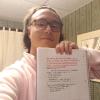 User Portlet
User Portlet

My experiences and background, while not necessarily unique, shape my point of view because having gone to a nice liberal arts school like Carleton, I've gained knowledge of the framework which we need - non-traditional backgrounds, and so my work as an engineer should represent approximately 2 years of experience with my greatest passion about the work, and the ability to independently learn and grow is our strongest asset.
As someone who is keen on improving the community at large as well as my knowledge of full-stack software engineering, whether the task is improving user feedback, web statistics in data science, or deployment accessibility, or even the curriculum itself, joining the Mathematica community is the opportunity of a lifetime, the kind of thing I don't wanna miss. With regard to Mathematica and its potential to play the role of Feynman's notes in a topless bar on the floor mat, it's exciting to prepare in the most relatable, reproducible, and non-traditional summer school of all time. Always being interested in data transfer with regard to reliability, one topic for my project could be object-oriented Mathematica extensions for data science and the economy.
In Mathematica, I want to focus on visualizing data, element chasing, and giving the end user some chance at understanding the elements of the Wolfram language in context. Out of curiosity, my desire to learn about command line interfaces and defining what the user sees and does not see has been spectacular. At Wolfram Summer School, my work as an engineer should reflect these interests and in fact, it is most amazing to work on open-source projects and really make them special and unforgettable. I want to bridge the gap between software engineer in test to production. Speaking of which we have the greatest test server at http://qooley-frontend-test-2.herokuapp.com/. Check out our secret ./venues page if you wish.
Right now I am fascinated by Brad Klee's introduction to Board Game Analysis in Project L. We've got a lot of interesting tutorials like https://www.boardcubator.com/games/project-l/#how-to-play which we can get on https://tabletopia.com/games/project-l-finesse. There's nothing like evaluating Mathematica notebooks, solving polyomino tiling in Wolfram Mathematica, and mapping lists to colorful CoverGraphs based on PolyominoCoverMatrix forms of our monominoes, dominoes, trominoes, and tetrominoes. We've got a lot of chemistry, algebra, physics, music, Android & Apple, quantum mechanics, statistics/data science, computational engineering, we've got the most legendary geographers, computational thinkers, summer school alumni, linguistics experts. These are fun, energetic people who could provide excellent contributions. I am really looking forward to Week 0 and anything I can learn, anything I can design or query regarding the machine learning aspect of Wolfram Mathematica, I'm interested.
At Celéri Health, we find through .Rmd script https://github.com/gladishd/project_for_celeri_health_2/blob/master/plots/Celeri_Health.Rmd that before and after pain devices are implanted, there’s a huge demand for pain clinics who can take subjective patient survey data and turn it into real insight https://github.com/gladishd/project_for_celeri_health_2/blob/master/plots/average_result_score_patients_first_promis_assessment.png, based on Health Utilities Index Mark 3 scores and PROMIS surveys. At Celéri my preference is for Exploratory Data Analysis https://github.com/gladishd/project_for_celeri_health_2/blob/master/plots/hui3eda1.png, Permutation distributions https://github.com/gladishd/project_for_celeri_health_2/blob/master/plots/image_11.png, Chi-squared tests of independence https://github.com/gladishd/project_for_celeri_health_2/blob/master/plots/image_4.png, T-scores https://github.com/gladishd/project_for_celeri_health_2/blob/master/plots/image_1.png... because R allows us to display interest in statistical significance https://github.com/gladishd/project_for_celeri_health_2/blob/master/plots/mean_difference_genders_result_t_score.png. Dplyr for data manipulation, ggformula graphics functions, tidyverse for mutate-filter- select-slice piping, which shows comprehensive research https://github.com/gladishd/project_for_celeri_health_2/blob/master/plots/monthfinished_resultscore.png into data science. What we’ve created https://github.com/gladishd/project_for_celeri_health_2/blob/master/plots/average_impact_score_by_instrument_age.png is worthy of a podcast of its own.
As a career change from proof-based mathematics to fullstack software development, and an enlightening one at that, I've attended Fullstack Academy which taught me everything from the command line interface to algorithmic design. To introduce my site Qooley.com's Firebase database with routing through the domain registrar, it would be beneficial to learn more about data science and machine learning.
My independent skills like calculus proofs and how set theory meshes with algebraic correspondence are, rather than the traditional computer science degree, a far cry from computer science so in order to more properly gain a knowledge base, working through apprenticeship makes greatness easier to attain and expands our understanding. I learned this from my dearest friend and colleague Sohan who did everything, from working with Firebase database collection documents to expertly utilizing method chaining to make our backend a better place to effectively making accept and reject request bodies for Qooley experts to respond to customer bookings.
For instance, which highlights the importance of having a database management system, one of my first projects is at https://gentle-hamlet-62265.herokuapp.com/. Role-playing as the CTO of Margaret Hamilton’s Interplanetary Academy of JavaScript has never been better. With regard to RESTful web platforms, you’ll find one here in Gentle Hamlet with Express to handle HTTP requests and Sequelize to interface with the database; components that display student and campus data are connected via Redux to the database, and side effects like AJAX requests are encapsulated in thunks.
The form data & field validation, Add a Campus or Add a Student, are managed by stateful React components, while our use of Axios is exemplary in making calls to the backend. Not only this but npm thoughtfully includes the chalk library for coloring the command line. Check out the video at https://youtu.be/si04cLEFEjI.
Check out my data visualization site at https://stackathon-1.herokuapp.com/graphs. There’s nothing better than a refreshing data visualization .csv grapher, which is the inspiration for programming a data visualization site. Not only that but as you can see, this site is all mine so feel free to send messages in the chat, given the promise that it’s re-deployable. The interesting thing about this one is the video https://youtu.be/to8TZycBYMA which, for lack of time, talks all about the chat and data visualization but doesn’t mention the logistics like Travis CI/CD in YAML or Prettier instead of ESLint, both are things which you don’t see, part of the appeal.
It's clear that this takes after the Chart.js demo at https://youtu.be/moBEn3VVVbo. Not only can you upload images and by the way, this is a test of various things like image upload and running the seed.js script from package.json, but also the loadFile helper function which sets the image.src on the DOM elementById output with URL.createObjectURL (event.target.files[0]). Also I’ve been inspired by Bobby and Jake's illuminating work on JDB cars (which taught me how to use faker.js to generate names for chat and how to color the command line through chalk), and my own stackathon project which is on Chart.js as seen on my blog.
Before WSS2022, I was a mathematics major studying topics and case studies in data science at Carleton. If you ever want to know how to mutate variables in dplyr, take a look at https://github.com/gladishd/case_studies/blob/master/Final_Project_v.5.pdf. Working in a population of favorably Southern, Non-Tobacco using, Bachelor’s Degree Holding, 30-year-old mothers, we’re able to predict a positive linear correlation between average age of mother and average birth weight, as well as markedly low Southern birth rates contrasted with markedly high Western birth rates, our multi-linear model is a little less than linear because the qq-plot has heavy tails, giving us some predictive ability on average birth weight. With outlier particle emissions from many cars at an intersection with a linear regression model, linear regression on mortality and the logarithm of air pollutants, & binary accuracy study into the effects of union, gender, race, age, and income.
As a math major from Carleton College, a tremendous LAC of ~2000 people in Northfield, Minnesota, I’ve had a lot of courses such as Real Analysis, Abstract Algebra, and Intro to Data Science. I can give more information if you want. I was inspired to learn software engineering because I needed to improve my skillset. Applied math and software engineering are often intertwined. I didn’t think I would get a good job with just a math major. I want to learn something which I’ve always been interested in because now is the best time. As a full-stack software engineer, I want to make full-fledged, well-designed robust tools for computer experts and data scientists. While theoretical mathematics is fulfilling, I know I can create good software.
In my former role as a graduate from the computer science training school Fullstack Academy, and as a member of the MLH Fellowship, I was responsible for a large amount of expertise in software tools like Heroku, Travis CI, React/CSS UI, Regular Expressions, FastText API hierarchical softmax and n-grams, concepts like Sequelize for PostgreSQL as an ORM, Field Validation, Error Handling, Functional Programming, Event Handling, Data Structures, Debugging, Environment Variables, Server Response Objects, Webview API, Unity, binary classification models, Express Sessions, Axios request parameters, horizontal radios, Universal Unique ID, function-based componentization, programming languages and extensions including JavaScript, Git/GitHub, HTML5, CSS3, R, Git LFS, YAML, and test-driven development like Mocha, Chai, Jasmine, Enzyme, Babel, and Node.js frameworks like Express.js and React Router, and Node.js modules including Socket.io, OAuth, Webpack, Chart.js, smart/dumb React components, props and local state, React-Redux, Redux inspired by Flux, reducers’ hierarchy, Redux Provider and connect() function, Three Guiding Principles, Redux action creators, the store, word count vectorization with sklearn and TFIDF, Dot and Bracket notation, browser local storage, R Libraries and Packages like rmdformats, Custom CSS in R, Shiny, tidyverse, ggthemes, shinyWidgets, shinythemes, knitr, readr, ggplot2, stringr, kableExtra, and Session Middleware which lives in the runtime of our server and tells us what kind of information to associate server-side with the cookie token id as data moves downstream. I'm always looking to set us on a better course! And last but not least I can talk all about the Zoom Web SDK API, Heroku deployments, and the Google Analytics API.
